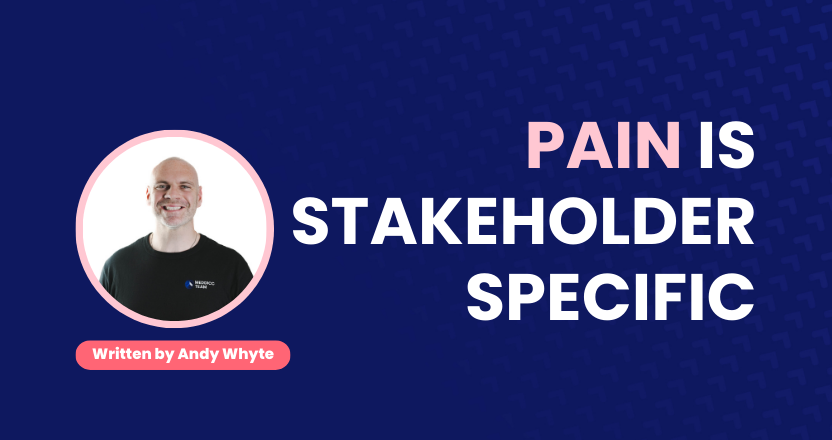A major mistake salespeople make is treating Pain as being company-specific. It is stakeholder-specific.
For example, if you sell a solution that prevents ransomware, you’ll find that the Pain will change from stakeholder to stakeholder. You could have a CISO as a Champion, and their Pain will relate to the responsibility of the security failure that led to the attack and the strain that will come in how their team responds. Working on Implicating the impact of these Pains with the CISO and quantifying them into Metrics is a great way to build them into being a Champion… But the work on Pain discovery has not finished.
It has barely begun! There will be other stakeholders, and we are yet to Identify their Pain…
For example, across the C-Suite, the Identified Pains could look like:
- CRO: Loss in revenue while their teams are locked out
- CMO: Damage to the brand if data is leaked
- CFO: Cost of the ransom and the potential fines if any data is leaked
- CPO: Risk to intellectual property that may be leaked
- COO: Business continuity
Just through this lens, you can already imagine the strength of a seller's proposition if they can go from having the Identified Pain of their Champion to the whole C-Suite.But we are still only at the Identified Pain level.
This is yet another reason why we say not all MEDDIC is equal, because we don’t believe merely Identifying Pain is enough. We believe the customer has to feel the Implications of the Pain, otherwise urgency will be absent.
The first step from Identifying Pain toward Implicating it is to Indicate the cost of the Pain. Indicating the Pain is where we work with the customer to quantify the cost of the Pain to their business.
Let's look at three stakeholders:
- CRO: Loss in revenue = $500k per 24 hours
- CFO: Cost of the ransom = $250k ransom
- CEO: Pressure from shareholders = -30% share price
Indicating Pain will increase urgency and the perception of the value your solution can bring… But we still have another level to get to.
Implicating the Pain!
CRO: What are the Implications of losing $500k in revenue a day for a week? What will that mean for your revenue goals? What cuts will need to be made to cover the shortfall in revenue? Layoffs? Cancellations of Initiatives?
CFO: If you pay the ransom, where will that budget come from? What other investment will be cut or delayed? What will the knock-on effects of that be?
CEO: What would these extra costs and losses in revenue mean for your goals this year? Which Initiatives will be impacted? What is the best/mid/worst case scenario?
Selling this way won't only increase your likelihood of winning, it'll also:
- Increase deal size
- Decrease time to close
- Create more sponsors who have skin in the game





.png)





.png)
























%201.png)










.png)
-1.png)
.png)
